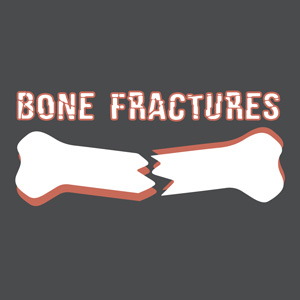 Your bones
protect your heart, lungs and brain. Bones are tough, but even the strongest
can break. Here's what you need to know about fractures and how to prevent
them.
Your bones
protect your heart, lungs and brain. Bones are tough, but even the strongest
can break. Here's what you need to know about fractures and how to prevent
them.
Signs a bone may be broken
Some fractures
are obvious. But the signs of a stress fracture or cracked bone can be more
subtle.
Don't ignore
these signs:
• Swelling or
tenderness.
• Bruising or
discoloration.
• A limb that
looks out of place.
Types of fractures There are different types of bone
fractures, including:
• Stable
fracture. The broken pieces line up cleanly.
• Open fracture. Bone
broke the skin when it was fractured.
• Transverse
fracture. The fracture forms a horizontal line.
• Oblique
fracture. The break is angled.
• Comminuted
fracture. The bone broke into more than two pieces.
When to seek care If you fall or have another injury that
causes pain, seek medical attention immediately. But even if you don't remember
hurting yourself, see the doctor if you have swelling, tenderness or something
that doesn't look right. It could be a fracture. After you've been treated,
remember that fractures take time to heal fully. It will stop hurting before
it's strong enough to support your normal activities. If you've been given a
cast or splint, keep using it until your provider says you're healed. If you do
have a cast, call your provider if you notice any cracks or soft spots.
Be
proactive Talk to your provider now about what you can do
to keep your bones strong and healthy. It's not just accidents or falls that
lead to fractures. Here are some things that put you more at risk for a broken
bone:
• Osteoporosis. This
disease weakens bones. Women age 65 and older should schedule a bone density
test to check for signs of osteoporosis.
• Family
history. If your relatives have had fractures, you may be
more at risk.
• Muscle
loss. Strong muscles keep you balanced, prevent falls and
lower the risk of fractures.
• Overuse. Repetitive
motion can cause stress fractures.
How to prevent fractures There's a lot you can do to make
broken bones less likely. Here are some prevention strategies:
• Get enough
calcium and Vitamin D.
• Exercise
regularly. Weight-bearing activities are especially helpful.
• Maintain a
healthy weight. If you don't weigh enough, it increases your
risk of bone loss.
• Don't smoke.
Smoking can shrink your bone mass.
• Remove
tripping hazards at home. Cords, rugs and clutter can all
cause falls.
Watson Clinic
specialists can help you achieve strong, healthy bones for life. Consult your
Family Medicine or Internal Medicine provider for tips on maintaining balance
and strength. Our Rheumatology department treats a wide array of complex
inflammatory conditions including osteoporosis and arthritis. Finally, our
Orthopaedic Surgery & Sports Medicine departments can help you recover from
injury through minimally invasive surgical and nonsurgical means.
Sources:
American Academy of Orthopaedic Surgeons; National Institute of Arthritis and
Musculoskeletal and Skin Diseases